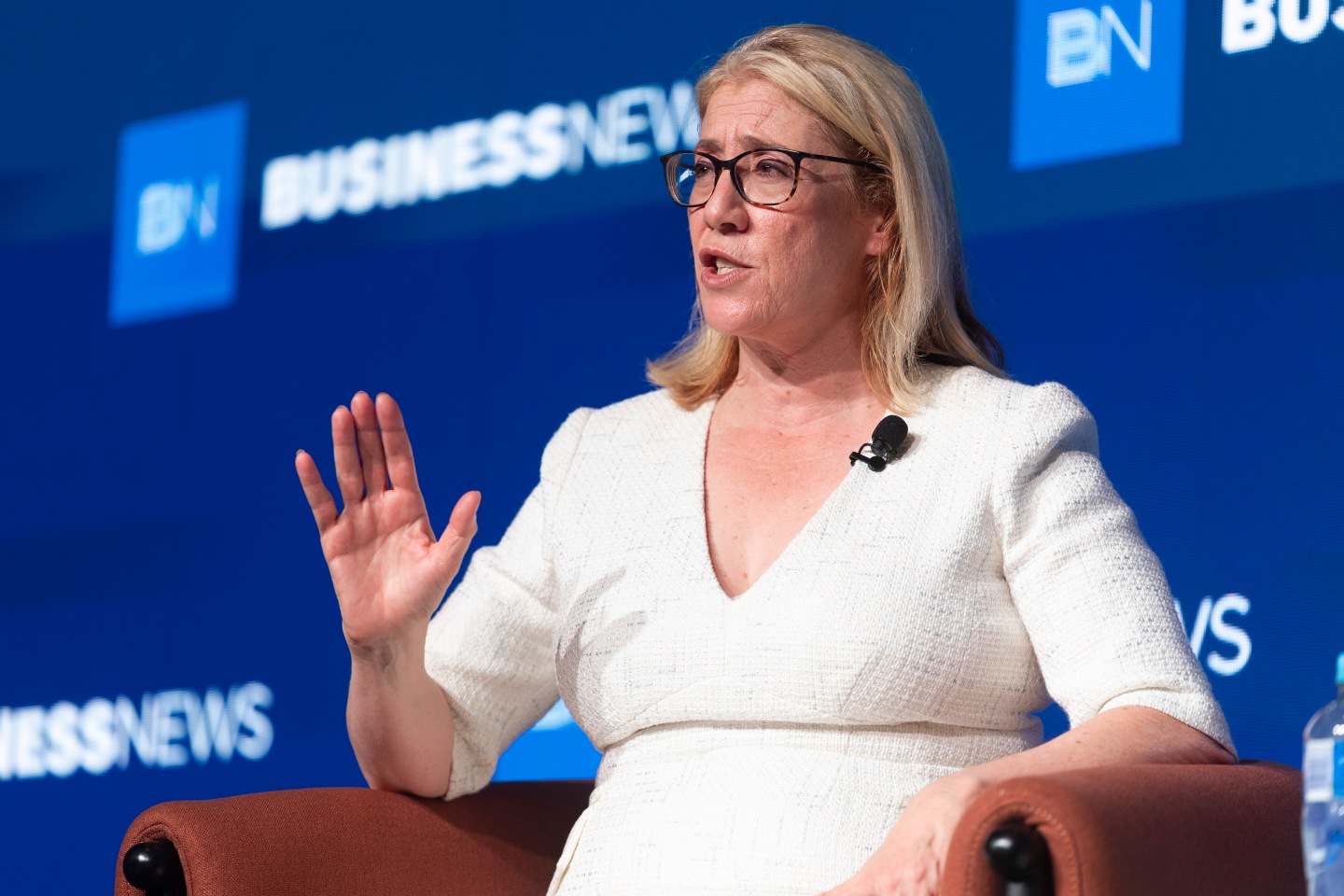Treasurer Rita Saffioti has backed the state’s ability to ride the bumps of iron ore price volatility and deliver its manufacturing agenda in her annual post-budget address this morning.


State Treasurer Rita Saffioti has backed the state’s ability to ride the bumps of iron ore price volatility and deliver its manufacturing agenda.
Addressing an audience of more than 1,000 at a Business News post-budget breakfast event this morning, the treasurer backed the state to navigate a turbulent global economy with the help of industry and the financial support of the government.
Ms Saffioti spoke to the importance of building domestic supply chains as a key learning from the Covid era, as she sold her message of a future made by Western Australian business, in WA.
She evaded questioning from Business News senior editor Mark Beyer on payroll tax relief – a bugbear for business in the state – and said the government would keep working at delivering the workers required to make a long-term manufacturing agenda a reality.
The treasurer also defended the state’s reporting its cash balance against questions over public sector debt.
Against the backdrop of a global trend towards political populism and nationalism Ms Saffioti stressed the significance of building things at home as a lesson in resilience from the pandemic.
She said there were instances in her political career where she had been shocked by the scale of work that government had previously sent offshore; a trend she sought to rectify with the government-funded domestic manufacture of railcars, power lines and ferries.
The state is also pressing ahead with major projects, including the Women and Babies Hospital and Westport, and has set up a new Office of Major Infrastructure Delivery to support their rollout – conceding there have been challenges in delivery in the past.
Below are some of the key takeaways.
Debt debate
The state projects yet another operating surplus in the coming financial year, but the cash position of the public sector is in deficit to the tune of $4.8 billion.
Questioned on the relevance of the projected surplus against the reported debt, Ms Saffioti – an economist who worked in the state’s Treasury Department for a number of years – highlighted that the state had long used net operating balance as a bottom line measure.
She said the state’s net debt as a percentage of gross state product was just over 9 per cent, even with a $38 billion infrastructure pipeline of works outlined.
“Other states are over twenty per cent and even more, so that is sustainability,” she said.
Ms Saffioti made a point of the fact the state owned its major energy, water and port utilities – unlike other states – and that their infrastructure spending weighed on the ultimate public sector debt profile.
“This is a big state with extraordinary demand, and to deliver the energy transition, to deliver the distribution networks, to connect new industry throughout the state, to deliver the new port upgrades – of which there is enormous demand – we need to continue to invest now,” she said.
“Without that investment in economic infrastructure, were not going to be able to turn these possibilities into reality.
“We need to continue to invest to get the jobs and the new projects in the state.”
She once again fell back on the state’s budgeting to a conservative long-term average iron ore price of $US72 per tonne – up from $US66/t in recent years – to absorb any budgetary shock that would come with an iron ore price drop and the royalties reduction that would come with it.
Ms Saffioti said the economic shock the state felt in 2015 would not happen under a government she led.
“We’ve been criticised for being too conservative in our forecasts, but it has and will protect us from any economic shock,” she said.
The price of iron ore fell well below even the state’s long-term average in 2015, when it was trading as low as $US40/t.

Rita Saffioti and Mark Beyer discuss the state budget. Photo: Matt Jelonek
Facilitating growth
Ms Saffioti endorsed the state’s training efforts, including free TAFE for key industries, as part of its bid to build the workforce required to deliver its desired manufacturing growth agenda.
She brushed off questions over the adequacy of the supply that would create against the overwhelming demand that could come from the thriving housing, mining, energy and defence industries sectors the government is hoping to build.
“We’ll keep working at it,” she said, pointing to a defence industries training initiative and the historic success of work to build a Metronet workforce.
“We’ve tailored our training programs to support new areas of industry,” Ms Saffioti said.
On project delivery, Ms Saffioti said the state had learned from experience when it came to cost blowouts.
Ms Saffioti said the state was prioritising retention of good people and rolling out the Office of Major Infrastructure Delivery (OMID) to address issues that have impacted past development projects.
“A lot of what we’re learning is basically ensuring we involve the builder earlier, and that helps in the design phase – about constructability and limiting scope change,” she said.
“That’s one of the key changes we’ll be implementing through OMID.”
The treasurer said her focus was for the state to deliver projects that would endure for generations ahead.
GST defensive
A post-budget breakfast would not be complete without a defence of the state’s GST windfall, and Ms Saffioti again highlighted that the “GST battle” continues.
The state is currently insulated by a price floor of 75c in the dollar for GST generated in WA.
The treasurer said the state was not against a per capita share model pitched by New South Wales – because it would result in a further $2 billion windfall for the state.
“As I consistently argue to the other state treasurers and to any eastern states commentator, without this deal we couldn’t be delivering the economic infrastructure that is supporting our new projects,” she said.
Yesterday’s state budget forecast an increase in WA’s GST share, with projections of GST revenue above the 75% mark in 2025-26.
It also highlighted a “significant risk” from the Productivity Commission’s review of GST distribution reform, to be handed down by the end of 2026.
MORE BUDGET COVERAGE:
- Saffioti delivers surplus, but debt rising
- Energy infrastructure a major focus
- Extra $163m in budget for Westport planning
- Opinion: Hard truths in mission for state
- Population growth puts pressure on $1.4bn housing budget
- Budget projects GST share rise
- Industry welcomes ‘practical’ budget

More than 1,000 attended the Post-Budget Breakfast this morning. Photo: Matt Jelonek












